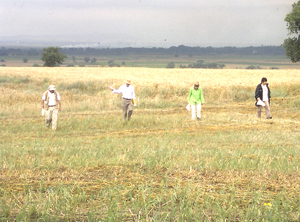
In 2004 Prof. Brian Rose (Curator-in-Charge, Mediterranean Section, University Museum; AAMW Chair) began a new multi-year project, The Granicus River Valley Archaeological Survey Project, focused on an area of northwestern Turkey that was controlled by both Greeks and Persians during the first millennium B.C. Looting there has become increasingly rampant due to the gold and silver objects still preserved in many of the tombs, and the new survey represents the first attempt to record and map both the settlements and burial mounds in this region.
The majority of the tombs are being explored with remote sensing (magnetometry and/or radar), while geophysical investigations (core-sampling) are being conducted around the Granicus River, where Alexander the Great launched a major battle against the Persian army in 334 B.C. Most of the tombs date from the late Archaic to the early Hellenistic period, and were set up by wealthy Anatolians associated with the Persian governor (or satrap) at the regional capital of Daskyleion. One of them yielded the earliest stone sarcophagus with figural scenes ever to have been found in the eastern Mediterranean, and the decoration features the murder of Polyxena, daughter of Priam. Another sarcophagus within the same tomb contained the body of a child surrounded by gold jewellery and silver symposium implements. A third sarcophagus (ca. 400-375 B.C.), with its paint still intact, contains a biographical narrative of the deceased, showing him victorious on the battlefield and in a boar hunt. These are Graeco-Persian products, carved primarily by Greek artists for Persian patrons.
